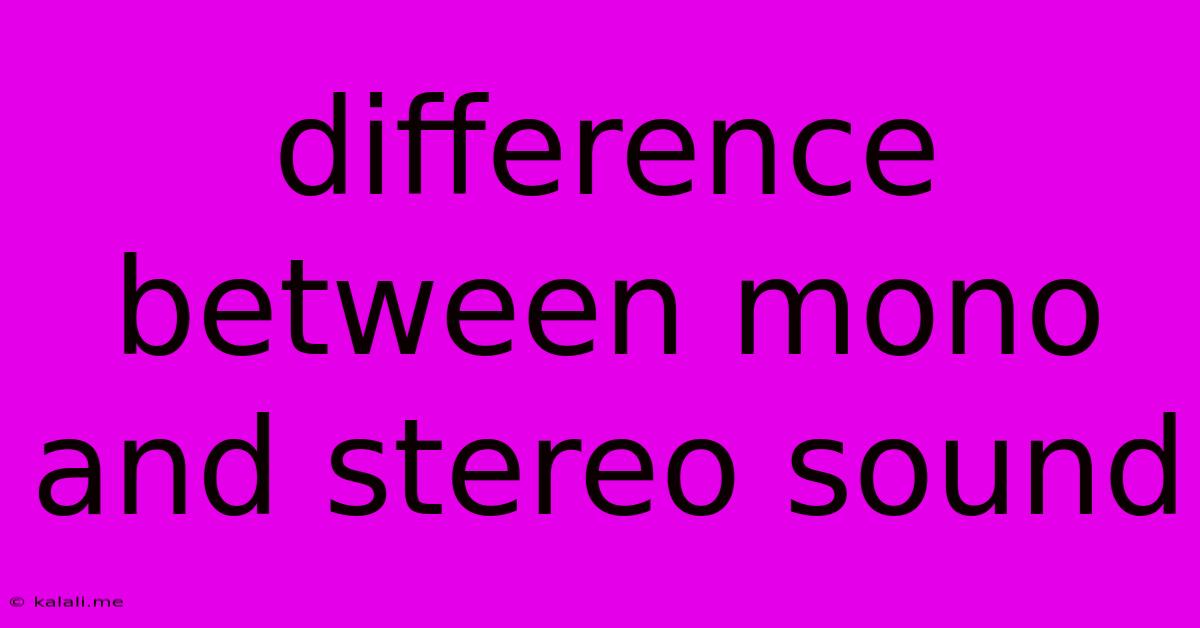Difference Between Mono And Stereo Sound
Kalali
May 22, 2025 · 3 min read

Table of Contents
Mono vs. Stereo Sound: Understanding the Differences
Understanding the difference between mono and stereo sound is crucial for anyone interested in audio, music production, or simply appreciating the nuances of sound. This article delves into the core distinctions, exploring their history, technical aspects, and the impact on the listening experience. Whether you're a seasoned audiophile or a curious beginner, this comprehensive guide will illuminate the world of mono and stereo audio.
What is Mono Sound?
Mono, short for monophonic, refers to a single-channel audio signal. This means all audio information—instruments, vocals, effects—is combined into one channel. Think of it like a single speaker playing all the sounds simultaneously. Early radio broadcasts and recordings were almost exclusively mono. The simplicity of mono means it's easy to produce and requires minimal equipment for playback.
Key Characteristics of Mono Sound:
- Simplicity: A single channel simplifies production, mixing, and playback.
- Less Spatial Information: Lacks the spatial depth and separation of instruments found in stereo. Everything is blended together in a single sonic space.
- Compatibility: Mono recordings are universally compatible; they can be played on any device, regardless of its stereo capabilities.
- No panning: Panning, or the placement of sounds in a stereo field, is not possible in mono.
- Powerful and direct sound: Due to its single-channel nature, mono can often sound more powerful and direct.
What is Stereo Sound?
Stereo, short for stereophonic, uses two or more channels to reproduce sound. This allows for a more realistic and immersive listening experience by creating a sense of space and depth. Each channel carries a slightly different audio signal, giving the illusion of sound coming from different locations. This is achieved through the use of multiple microphones during recording or through mixing in post-production.
Key Characteristics of Stereo Sound:
- Spatial Depth: Instruments and vocals are placed in a three-dimensional soundstage, enhancing realism and immersion.
- Improved Clarity: Separation of instruments and vocals enhances clarity and prevents masking.
- Panning Capabilities: Sounds can be panned (moved) left, right, or anywhere in between, creating a wider and more dynamic soundscape.
- Enhanced Realism: Creates a more realistic and natural representation of a live performance or recording environment.
- More Complex Production: Stereo production requires more advanced equipment and expertise.
Comparing Mono and Stereo: A Table Summary
| Feature | Mono | Stereo |
|---|---|---|
| Channels | One | Two or more |
| Spatial Depth | Limited | Significant |
| Clarity | Less distinct | More distinct |
| Panning | Not applicable | Applicable |
| Production | Simple | More complex |
| Immersion | Less immersive | More immersive |
| Compatibility | Universally compatible | Requires stereo playback equipment |
The Evolution and Continued Relevance of Mono
While stereo has become the dominant format, mono still holds a significant place in the audio world. Many older recordings are in mono, and certain genres, such as some types of electronic music, still utilize mono for specific effects. Additionally, mono compatibility remains essential for ensuring broader accessibility.
In Conclusion:
Mono and stereo represent distinct approaches to sound reproduction, each with its own strengths and applications. Mono offers simplicity and compatibility, while stereo provides a richer, more immersive experience. Understanding the fundamental differences between these formats allows for a deeper appreciation of the technical aspects and artistic choices involved in audio production and consumption.
Latest Posts
Latest Posts
-
How To Unscrew A Stuck Screw
May 22, 2025
-
25 Or 6 To 4 Meaning
May 22, 2025
-
How Long Does A Tire Alignment Take
May 22, 2025
-
My Child Will Have A Different Father
May 22, 2025
-
Work Out Your Salvation With Fear And Trembling
May 22, 2025
Related Post
Thank you for visiting our website which covers about Difference Between Mono And Stereo Sound . We hope the information provided has been useful to you. Feel free to contact us if you have any questions or need further assistance. See you next time and don't miss to bookmark.